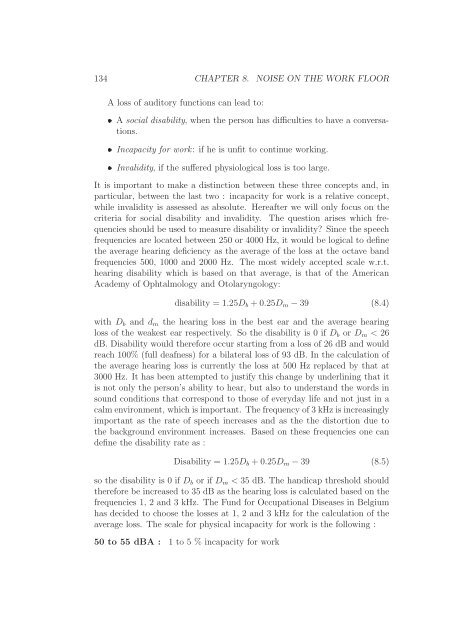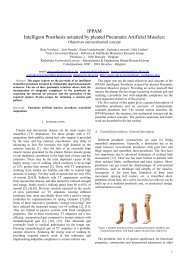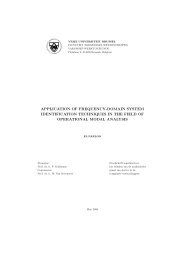VRIJE UNIVERSITEIT BRUSSEL Acoustics - the Dept. of ...
VRIJE UNIVERSITEIT BRUSSEL Acoustics - the Dept. of ...
VRIJE UNIVERSITEIT BRUSSEL Acoustics - the Dept. of ...
Create successful ePaper yourself
Turn your PDF publications into a flip-book with our unique Google optimized e-Paper software.
134 CHAPTER 8. NOISE ON THE WORK FLOORA loss <strong>of</strong> auditory functions can lead to:A social disability, when <strong>the</strong> person has difficulties to have a conversations.Incapacity for work: if he is unfit to continue working.Invalidity, if <strong>the</strong> suffered physiological loss is too large.It is important to make a distinction between <strong>the</strong>se three concepts and, inparticular, between <strong>the</strong> last two : incapacity for work is a relative concept,while invalidity is assessed as absolute. Hereafter we will only focus on <strong>the</strong>criteria for social disability and invalidity. The question arises which frequenciesshould be used to measure disability or invalidity? Since <strong>the</strong> speechfrequencies are located between 250 or 4000 Hz, it would be logical to define<strong>the</strong> average hearing deficiency as <strong>the</strong> average <strong>of</strong> <strong>the</strong> loss at <strong>the</strong> octave bandfrequencies 500, 1000 and 2000 Hz. The most widely accepted scale w.r.t.hearing disability which is based on that average, is that <strong>of</strong> <strong>the</strong> AmericanAcademy <strong>of</strong> Ophtalmology and Otolaryngology:disability = 1.25D b +0.25D m −39 (8.4)with D b and d m <strong>the</strong> hearing loss in <strong>the</strong> best ear and <strong>the</strong> average hearingloss <strong>of</strong> <strong>the</strong> weakest ear respectively. So <strong>the</strong> disability is 0 if D b or D m < 26dB. Disability would <strong>the</strong>refore occur starting from a loss <strong>of</strong> 26 dB and wouldreach 100% (full deafness) for a bilateral loss <strong>of</strong> 93 dB. In <strong>the</strong> calculation <strong>of</strong><strong>the</strong> average hearing loss is currently <strong>the</strong> loss at 500 Hz replaced by that at3000 Hz. It has been attempted to justify this change by underlining that itis not only <strong>the</strong> person’s ability to hear, but also to understand <strong>the</strong> words insound conditions that correspond to those <strong>of</strong> everyday life and not just in acalmenvironment, whichisimportant. Thefrequency <strong>of</strong>3kHzisincreasinglyimportant as <strong>the</strong> rate <strong>of</strong> speech increases and as <strong>the</strong> <strong>the</strong> distortion due to<strong>the</strong> background environment increases. Based on <strong>the</strong>se frequencies one candefine <strong>the</strong> disability rate as :Disability = 1.25D b +0.25D m −39 (8.5)so <strong>the</strong> disability is 0 if D b or if D m < 35 dB. The handicap threshold should<strong>the</strong>refore be increased to 35 dB as <strong>the</strong> hearing loss is calculated based on <strong>the</strong>frequencies 1, 2 and 3 kHz. The Fund for Occupational Diseases in Belgiumhas decided to choose <strong>the</strong> losses at 1, 2 and 3 kHz for <strong>the</strong> calculation <strong>of</strong> <strong>the</strong>average loss. The scale for physical incapacity for work is <strong>the</strong> following :50 to 55 dBA : 1 to 5 % incapacity for work
















